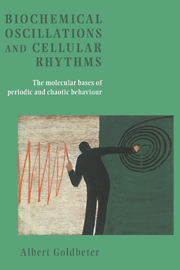Book contents
- Frontmatter
- Contents
- Foreword to the English edition by Michael Berridge
- Foreword to the French edition by Ilya Prigogin
- Preface
- 1 Introduction
- Part I Glycolytic oscillations
- Part II From simple to complex oscillatory behaviour
- Part III Oscillations of cAMP in Dictyostelium cells
- Part IV From cAMP signalling in Dictyostelium to pulsatile hormone secretion
- Part V Calcium oscillations
- Part VI The mitotic oscillator
- 10 Modelling the mitotic oscillator driving the cell division cycle
- Part VII Circadian rhythms
- References
- Index
10 - Modelling the mitotic oscillator driving the cell division cycle
Published online by Cambridge University Press: 26 February 2010
- Frontmatter
- Contents
- Foreword to the English edition by Michael Berridge
- Foreword to the French edition by Ilya Prigogin
- Preface
- 1 Introduction
- Part I Glycolytic oscillations
- Part II From simple to complex oscillatory behaviour
- Part III Oscillations of cAMP in Dictyostelium cells
- Part IV From cAMP signalling in Dictyostelium to pulsatile hormone secretion
- Part V Calcium oscillations
- Part VI The mitotic oscillator
- 10 Modelling the mitotic oscillator driving the cell division cycle
- Part VII Circadian rhythms
- References
- Index
Summary
The eukaryotic cell cycle is driven by a biochemical oscillator
Few cellular processes are as crucial as that governing cell division. The tight control of cell division indeed plays a prominent role in development and differentiation, while unrestrained proliferation is associated with the cancerous state. The control of the eukaryotic cell division cycle therefore represents a central issue in cell biology (for reviews of recent experimental advances, see the special issues of Science, 246:603-640 (1989) and of the Journal of Cell Science, Suppl. 12 (1989), as well as volume LVI of Cold Spring Harbor Symposium on Quantitative Biology (1991), and Cross et al., 1989; Hunter, 1992; Norbury & Nurse, 1992; Murray & Hunt, 1993; Heichman & Roberts, 1994; King, Jackson & Kirschner, 1994; Nurse, 1994; Peter & Herskowitz, 1994; Sherr, 1994). The cell cycle is classically portrayed as a sequence of phases (fig. 10.1): following mitosis (M) come, successively, the Gx phase leading to the S phase of DNA replication, and the G2 phase, which separates the latter from the next M phase; sometimes cells stay in a quiescent phase, Go, prior to their entry into Gt. The fact that in dividing cells mitosis recurs at regular intervals (whose duration, varying with the cell type, ranges from 10 min up to 24 h or even more) has for a long time raised the possibility that the cell cycle is driven by a continuous biochemical oscillator.
- Type
- Chapter
- Information
- Biochemical Oscillations and Cellular RhythmsThe Molecular Bases of Periodic and Chaotic Behaviour, pp. 409 - 456Publisher: Cambridge University PressPrint publication year: 1996

